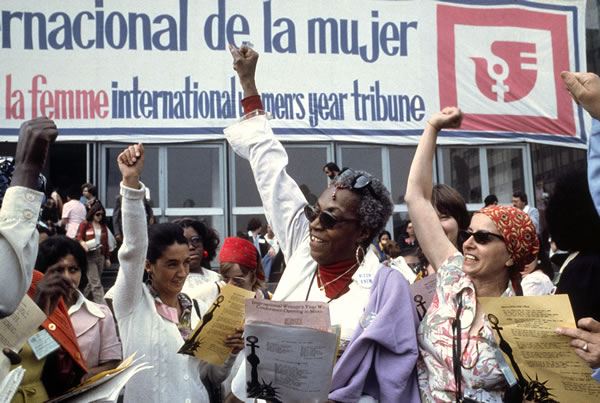History of Women’s Day
International Women’s Day is celebrated in many countries around the world. It is a day when women are recognized for their achievements without regard to divisions, whether national, ethnic, linguistic, cultural, economic or political.
Since those early years, International Women’s Day has assumed a new global dimension for women in developed and developing countries alike. The growing international women’s movement, which has been strengthened by four global United Nations women’s conferences, has helped make the commemoration a rallying point to build support for women’s rights and participation in the political and economic arenas.
We invite you to learn about the history of women’s rights and the UN’s contribution to the cause.
First key years of the movement
Officially recognized by the United Nations in 1977, International Women’s Day first emerged from the activities of labour movements at the turn of the twentieth century in North America and across Europe:
Movement in the United States
The first National Woman’s Day was observed in the United States on 28 February. The Socialist Party of America designated this day in honour of the 1908 garment workers’ strike in New York, where women protested against working conditions.
But the first milestone in US was much earlier – in 1848. Indignant over women being barred from speaking at an anti-slavery convention, Americans Elizabeth Cady Stanton and Lucretia Mott congregate a few hundred people at their nation’s first women’s rights convention in New York. Together they demand civil, social, political and religious rights for women in a Declaration of Sentiments and Resolutions. A movement is born.
Did you know?
- The fact that Women’s Day is celebrated on March 8th is strongly linked to the women’s movements during the Russian Revolution (1917).
- New Zealand was the first self-governing nation to allow women to vote.
- In the first known campaign of its kind, the Egyptian Society of Physicians went against tradition by declaring the negative effects of female genital mutilation. This was in 1920.

October 24, 1945
UN Charter: “Fundamental freedoms for all”
Established on 24 October 1945 to promote international co-operation following the devastation of World War II, the UN has since its inception enshrined the equal rights of men and women at the heart of its raison d’être. Its founding charter outlines that among its purpose is to promote and encourage “fundamental freedoms for all without distinction as to race, sex, language, or religion.” Less than a year later during the inaugural session of the UN General Assembly in London, U.K., Frieda Dalen of Norway becomes the first woman delegate to address it and Eleanor Roosevelt of U.S.A. famously reads an “open letter to the women of the world” urging for their increased involvement in national and international affairs.
Tracking progress: Commission on the Status of Women
A functional commission of the United Nations Economic and Social Council (ECOSOC), the Commission on the Status of Women+ (CSW) is established as the first global intergovernmental body exclusively dedicated to the promotion of gender equality and the empowerment of women. Instrumental in monitoring the status of women’s rights worldwide and shaping global standards on gender equality, the Commission brings together Member States, civil society organizations and UN entities to assess gaps and evaluate progress on an annual basis. In the Commission, Member States agree on actions to accelerate the achievement of women’s rights and empowerment.

December 10, 1948
One giant leap for humanity: The Universal Declaration of Human Rights
Adopted by the UN General Assembly in 1948, the landmark Universal Declaration of Human Rights is the first global recognition that there are basic inalienable rights and fundamental freedoms that apply to every human being. Drafted as “a common standard of achievement for all peoples and nations,” the Declaration for the first time in human history spells out basic civil, political, economic, social and cultural rights that all human beings — men and women alike — should enjoy. The cornerstone for modern human rights, the Declaration together with the International Covenant on Civil and Political Rights (1966) and the International Covenant on Economic, Social and Cultural Rights (1966) forms the International Bill of Human Rights.

March 8, 1975 — December 31, 1985
A time to celebrate: International Women’s Day, Year & Decade
In 1975, during International Women’s Year, the UN begins commemorating International Women’s Day (8 March). Two years later, the UN General Assembly officially formalizes the Day — although the first observance dates back to 28 February 1909, when the Socialist Party of America designated the day to honour a garment workers’ strike the year prior in New York. Coinciding with International Women’s Year, the first World Conference on Women takes place in Mexico, 19 June-2 July 1975. It is here where a 10-year World Plan of Action for the Advancement of Women is formed, following which the UN General Assembly proclaims 1976-1985 the United Nations Decade for Women: Equality, Development and Peace to implement the action plan.
The golden standard: Women’s Bill of Rights
In 1979, The UN General Assembly adopts the Convention on the Elimination of All Forms of Discrimination against Women (CEDAW). Often referred to as the “Women’s Bill of Rights”, CEDAW is the most comprehensive international instrument to protect the human rights of women. It defines the meaning of discrimination against women and establishes legal obligations for countries that are parties to it (i.e. States Parties) to end such discrimination. More specifically, the Convention requires States Parties to eliminate discrimination against women in the public as well as the private sphere, including the family, and aims to achieve substantive equality between women and men — not just in laws, but also in reality on the ground. As of 2015 with 189 States Parties, it is the second most ratified UN human rights treaty after the Convention on the Rights of the Child.


